The content is published under a Creative Commons Attribution Non-Commercial 4.0 License.
Reviewed Article:
Before They Dyed. Mordants and Assists in the Textile Dyeing Process in Anglo-Saxon and Anglo-Scandinavian Britain: An Experimental Approach
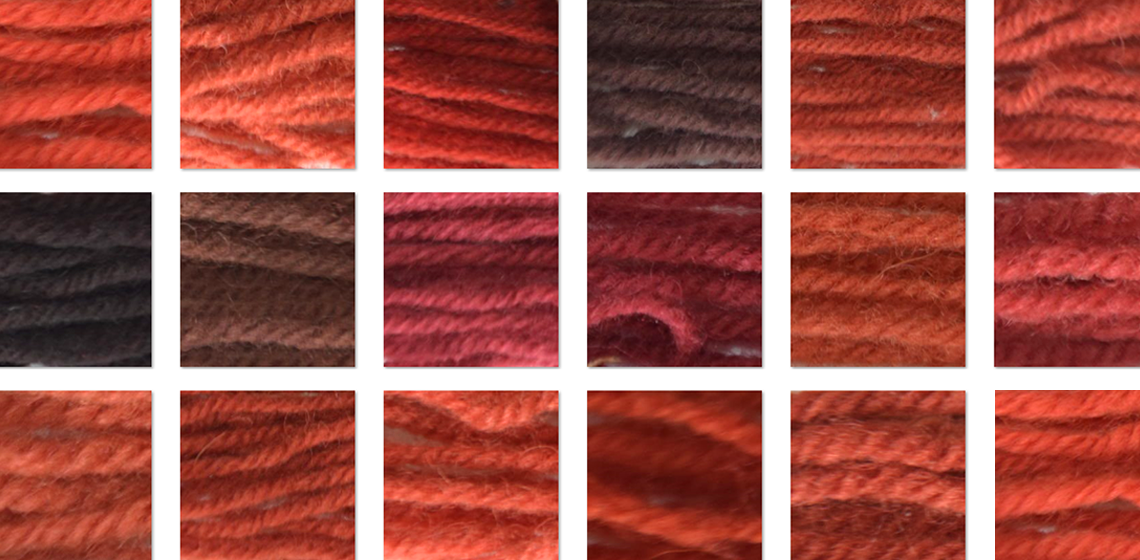
The experiment aimed to investigate certain aspects of the textile dyeing process in Anglo-Scandinavian and Anglo-Saxon Britain: substances known as mordants and assists. This aspect of the dyeing process is often omitted by researchers, who mostly focus on dyestuff as a source of colour. Mordants and assists deserve wider research, however, as they play a great part in the dyeing process and can radically change the outcome. They are derived from different sources, both mineral and organic, and are added during the dyeing process to influence the final result, mostly in aspects of shade and/or fastness.
For the experiment, madder (Rubia tinctorum) was chosen as a dyestuff, as it was one of the most popular dyeing plants in Britain before the Norman Conquest. The fibre of choice used for the experiment was wool spun from the Shetland sheep fleece. Investigation of several sources, written, archaeological and ethnographic, allowed compilation of a list of 16 mordants and assists which were available to use in Early Medieval Britain during the pre-Conquest period. One untreated sample was prepared as a comparison. During and after dyeing, quantitative and qualitative data were collected about pH of the solution, final colour (measured with a colourimeter) and lightfastness (measured with a Blue Wool Scale). A wide range of colours was obtained, and it was found that, in general, adding mordants/assists improved lightfastness.
Introduction
Historical textile dyeing is often shrouded in mystery. Dyeing before the time of craft guilds, performed on a small scale in households, is a particularly difficult subject to research. In England, the period extending roughly through the Anglo-Saxon and Anglo-Scandinavian era untill the Norman conquest, was dominated by small-scale dyeing. As we know about some dyestuffs used, we can replicate colours to a certain degree, but details of the dyeing process usually remain lost to time. This lack of information is very frustrating for researchers interested in the subject of early Medieval textile crafts.
This experiment is an attempt to investigate some of the less known details of the dyeing process. Substances used as mordants and assists used in domestic dyeing during the Anglo-Saxon and Anglo-Scandinavian periods were researched by the author. The aim was to explore if and how the final colour was affected by adding mordant or assist in the aspect of both lightfastness and shade.
Mordants and assists in the past
Mordants and assists are an inherent part of the dyeing process; however, they are not dyestuffs. They are extra substances added during the dyeing process to influence the final shade and/or fastness. These substances can be derived from different sources, both mineral and organic.
There are significant differences in the definition of mordants and assists both in archaeological and natural dyeing literature. The word ‘mordant’ is often used to describe every substance not being the dyestuff, added intentionally to the dye bath to help with dyeing, colour fastness, etc. It is more correct to say only some of these substances may be called the mordants, as according to the definition, mordant is a metal salt used to fix a dye in the fibre. In the case of protein fibres (such as wool, silk), mordant binds to the fibre, and then dye binds to a mordant (Boutrup and Ellis 2018, 51). Assists can be described as substances used as an aid in the dyeing process, which, from the chemical point of view, do not act as mordants (do not create a bond between the dyestuff and a fibre). They are used to change the chemical structure of the mordant, to modify the pH or to help fix the mordant on the textile (Boutrup and Ellis 2018, 56).
Some mordants have a long history. One early written source, Leyden papyrus X (written in 3rd century AD) lists the following substances used as mordants and assists: pine-cones, the inside of the Persian nuts (walnuts), purpura, beet juice, less of wine, camel urine, inside of citrons, navelwort, alum, melantheria (iron and copper sulphate), scorched vitriol, chalcitis, cinnabar, lime, the bark of pomegranate, pods of the acacia tree, urine with aloe, seaweed, lime, vinegar, natron (after Sherwood et al. 1997, 362).
There is a possibility that in some cases, mordants were applied in a form dissolved in water. Water from particular sources could be considered well suited for dyeing due to its mineral content. For example, in an ancient Grecian case described by Strabo’s Geography (7th century BC):
The water at Hierapolis is also wonderfully suited to the dyeing of wools, so that the wool dyed with madder-root is comparable to the ones dyed with the kermes and with sea-purple
(after Sherwood et al. 1997, 358).
Conscious usage of mordants in medieval Britain may be observed in a fragment from 13th – 14th century York. The striped piece of fabric was woven from undyed yarn and yarn dyed in madder. The madder-dyed stripes were in two different shades. While it is a possibility that the madder of the brown stripe bled from adjacent red, it is more probable that two different mordants were used (alum and possibly iron – Walton 1989b, 401).
Materials
Initial data about possible mordants and assists were gathered from previous textile archaeological research as well as from folklore surveys. This research was a basis for choosing 16 substances and possible methods for their application (listed below).
The substances were tested in a dyebath with madder (Rubia tinctorum), as this plant is commonly considered the most popular mordanted dyestuff in an Anglo-Saxon and Anglo-Scandinavian context (Walton 1989a, 17 – 19).
The fibre of choice was wool, as this fibre was most commonly used and also it accepts dyes well. The yarn for the samples was spun from Shetland sheep fleece, as this breed’s fleece represents a hairy medium type, which was one of the most common in the Anglo-Saxon and Anglo-Scandinavian Britain from 7th century until the Norman Conquest (see Walton 1989b, 306, table 14, further references there).
Methods and equipment
The focus was to examine the mordants and assists and their influence on colours; therefore, the important issue was to eliminate impurities during the dyeing process. There are many possible ways that additional chemicals can be utilised during the dyeing process. To minimize possible contamination, demineralized water and modern stainless-steel pots have been used. The yarn selected for the experiment was scoured (cleaned) in a pH-neutral detergent and thoroughly washed to remove potential impurities from contaminating the dyeing process (originally, mostly stale urine was used as a cleaning agent).
During the dyeing process, data was collected by measuring the temperature and pH value. After the dyeing, the qualitative data was collected by observation and noting the colour of the samples. They were also compared to the un-mordanted sample.
Colours were also examined with a colorimeter to observe the objective standard. The measurements were done with the Color Muse colorimeter, the measuring area being 4 mm in diameter.
The lightfastness was measured with Blue Wool Scale. The Blue Wool scale, with a rating scale of 1 to 8, uses samples of wool dyed with 8 different blue pigments, each of which fade after different exposure times: 1 being the least resistant and 8 being the highest. The ratings are: 1 = Very poor (fugitive), 2 - 3 = Poor (fugitive), 4 – 5 = Fair (impermanent), 6 = Very Good, 7 - 8 = Excellent. As soon as a visible change occurs in the exposed area of that blue wool sample, the light exposure has reached the level to which it is rated. When the tested material starts to show visible changes, it is compared to the corresponding area of visible change on the samples of the scale and is given a lightfastness rating.
Samples were exposed to natural sunlight for approximately 8 - 10 hours per day.
General Method
Mordanting/Assisting
In most cases, applying the mordants/assists was performed before dyeing. For these cases, the procedure took place as follows:
After cleaning, samples of yarn were soaked throughout in water. Mordants/assists were dissolved in water (or added to water, if in a liquid form), and the yarn was placed in the stainless-steel pot
The mixture was heated slowly and kept for one hour at a temperature of no higher than 90°C (to prevent felting fibres), being stirred occasionally, then left to cool overnight.
In some cases, when obtained information suggested so, mordants/assists were applied during or after dyeing.
A detailed description of the procedure in each case follows with the description of mordant/assist.
Dyeing
The dyeing process was a formula based on previous experiments undertaken by the author during their MA dissertation research and the literature about natural dyeing (Boutrup and Ellis 2018; Dean 2010 and 2014, Peachey 2013).
Madder is considered a strong dyestuff and, therefore, quite often used in relatively small amounts; however, to receive a maximum depth of colour in this experiment, a proportion of 1:1 of dyestuff and fibres were used. For 17 skeins with an overall weight of 85 g, the same weight of madder was used to prepare the dyeing bath. Madder was prepared according to Jenny Dean’s publication (2014 119). The dried ground roots and rhizomes were soaked overnight in water. The next day the liquid was simmered (60 – 80°C) for an hour and left to cool and strained.
The dyestuff created this way was divided equally into 17 parts. Each part was used to dye one sample in a separate pot (to prevent contamination from substances used to treat other samples). The same procedure was applied: after placing the sample in the dye bath, the temperature was gradually raised to 80° and maintained for 40 minutes. The sample was then thoroughly washed with tap water and dried (See Figure 1).
Mordants and assists used in experiments
Mordants
1. Aluminium salts
The most common mordants used in a contemporary setting amongst natural dyers are different aluminium salts, where the active component is aluminium. Alum has been used since antiquity, as noted by Pliny in Natural History (after Sherwood et al. 1997, 357), who wrote:
In Cyprus there is a white and a darker alum, and although the difference in colour is small, there is a great difference in use since the white and liquid type is most useful for dyeing wools with a bright colour, while the dark type is best for dark and sombre colours.
Aluminium salts in mineral form were not imported to Britain until the later Middle Ages (Owen-Crocker et al. 2012, 176). Their presence in examined textiles from Anglo-Saxon times indicates that they were obtained in some other way, probably from plants. In some cases, aluminium present on excavated textiles might occur after deposition (due to minerals present in the soil), but it can be also a result of the action of a dyeing agent. It is probable that Anglo-Saxon dyers used certain plants which were capable of absorbing the aluminium through their roots and accumulating this mineral in their tissues (Hartl et al. 2015). These particular species gained the reputation for being suitable for dyeing, even if the exact reason was not known.
There were various aluminium-bearing plants available to the Early Medieval dyer in Britain. Traditionally used in folk-dyeing across Europe are species of the Lycopodiaceae family (clubmoss): clavatum, complanatum, alpinum, and Huperzia selago (Cardon 2007, Drozdowski 1911, 506). The use of Lycopodiaceae in domestic dyeing was documented among the other ones in Scotland, Scandinavia, Iceland (Grierson 1992 and Poland (Drozdowski 1911).
The best-known aluminium-bearing plant from Early Medieval Britain is Lycopodium complanatum, whose remains were found during the excavations in Jorvik (Anglo-Scandinavian York). The other dyeing plants were found nearby, which indicates that Lycopodium was most probably used in the dyeing process. As this plant is not a native specimen, it was probably imported from Scandinavia or North Germany, which may suggest that its role in the dyeing process was highly valued (Kenward and Hall 2004; Walton 1989b; Walton 1997).
Different lycopodiae listed above, as well as different aluminium bearing plants, may have been used as well. Known specimens theorised to be used in European folk dyeing are:
- Common chickweed (Stellaria media) (Vajanto 2015, 33)
- Horsetails: Field horsetail (Equisetum arvense) and forest horsetail (Equisetum silvaticum) (Vajanto 2015, 47 – 62). These species contain 1 – 2 % aluminium and other salts. It has been observed that other dyestuffs work better after usage of horsetail (Kelso 2011, 310)
- Eagle fern (Pteridium aquilinum) (Vajanto 2015, 62).
For the experiment, Lycopodium complanatum species was chosen as it has been shown that almost certain it was used as a mordant. Another chosen plant was a field horsetail (Equisetum arvense). Even if field horsetail contains a relatively low amount of aluminium, it is a common invasive plant growing in large quantities; therefore would have been relatively simple for a dyer to collect the needed quantity.
One sample mordanted in mineral alum was also prepared to compare results with mordanting in plant-derived alum (See Figure 2).
Method The sample mordanted in mineral alum was prepared according to a general procedure described above. For each of the samples mordanted in plant-derived alum (clubmoss and field horsetail), a recipe after Dean (Dean 2014) was selected. The plant material was placed in a dye pot and covered in water. The mixture was heated to 40° C. This temperature was kept for three days, boiled once briefly, then strained and kept cool. The fibre material was added and the mixture was heated up slowly to 40° C, after that the heat was turned off. This process was repeated for three days. Finally, the fibre material was allowed to cool in the solution overnight, removed, squeezed well, and rinsed. In the case of clubmoss, Dean (2014) advised the following proportion of dyestuff to fibre: 2 parts of clubmoss for one part of fibre; therefore for a sample of 5g weight, 10 g of clubmoss was used. The sources mentioning field horsetail used as a mordant do not describe details of the mordanting process and required proportion; however, due to the relatively low content of the aluminium and the fact that the field horsetail was (and still is) a common plant, which would have been simple to obtain in large amounts, the bulk amount was used: 125 g of plant for one sample weighing 5 g. It should be noted that Dean’s (2014) recipe is not the only possible version. From ethnography, there are known several different procedures of extracting alum from plants. The most common method involves placing the plant in water or (putrid) urine and heating the liquid (Bielenstein 1935; Grierson 1989) (See Figure 3). |
2. Iron and copper salt
Iron and copper compounds was found in many textiles from the Anglo-Saxon period on the British Isles (Owen-Crocker et al. 2012, 176). Again, as in the case of alum, they might be either the result of contamination from the soil or as a result of the dyeing process (Hartl et al. 2015, 586). Metal used during dyeing may have been obtained from several sources. It is often suggested that both iron and copper could be used in the form of scrap metal added to the dyeing pot to contribute to the successful completion of dyeing. The other possibility is the usage of pots made of these metals. It is also possible that water used for the dyeing process could contain some copper or iron compounds. A simple way to obtain iron for mordanting was by applying water from a quenching bucket (used for blacksmiths to cool iron tools during the forging process, see Moszyński 1929, 373). Also, copper and iron acetates were possibly made by treating copper, bronze, and iron objects with vinegar (Grömer 2016, 154).
Method Due to the potential toxicity of copper, it is arguable that only iron was used as a mordant. In total, three samples mordanted in iron were prepared for dyeing. In the first case, a recipe used by modern dyers was used. The yarn was mordanted with pure iron sulphate in the amount of 0,5 g (10% weight of fibre). In a separate experiment, water from a bucket used for quenching (a practice still used in blacksmithing) containing iron particles was used in an undistilled form. It was used on two samples, one before and one after dyeing; 500ml of the solution was used. In the third sample, iron mordant was applied in the form of ‘iron water’ prepared according to a Jenny Dean recipe (2014, 36). Scrap iron was placed in a container and covered with the solution of two parts water to one part vinegar (organic apple vinegar was used). The mixture was left to steep for two weeks. The ‘iron water’ was also applied on two samples: in the first one, before dyeing and after dyeing in the second one. 500 ml was used in each sample. |
In all three samples, the general procedure as described above was followed.
Assists
1. Lye and ash
Lye is an alkaline substance traditionally obtained by leaching wood ash. Adding lye changes the pH balance, which may dramatically influence the final colour of the material used for dyeing.
Ash, or lye made from the processing of ash, is one of the most common assists used in textile dyeing throughout the centuries. The cases closest to the times described in this paper come from early Anglo-Norman receipts, which may suggest the lye and ash were known even earlier. Wood ash lye was advised to be used when dyeing yellow with Genista tinctoria; another recipe recommends ash from burned danewort (Sambucus ebulus) as an aid when dyeing silk (Hunt 1995, 209). Other examples of using ash in the dyeing process come from Papyrus Graecus Holmensis (Kirby et al. 2013, 36), Irish folk dyeing (Mahon 1982, 115), and a 16th-century Dutch recipe: ash with weld (Kirby et al. 2013, 41).
Method The lye used in the experiment was created taking as a base technique recommended by Dean (2014, 35) from ash received after burning hardwood (mostly birch). Ash was sieved to remove larger impure particles and derive a fine powder. It was then placed in a stainless-steel mesh and then sieved with distilled, boiling water. The procedure was repeated twice, and 0.5% of strongly alkaline liquid (lye) was received as a result (final pH was 11). Various recipes advise adding lye during dyeing or after dyeing. However, as experiments proved (Vajanto 2015), applying a strong alkaline when the solution is still hot may damage the fibres; therefore, the first option seems to present more risk to a successful outcome of the dyeing process. Despite this concern, both options were tested. In both cases, amounts of lye sufficient to raise the pH to 10 were added to the dyeing bath (around 75 ml of lye for 450 ml of dyestuff). (See Figures 4-6) |
2. Tannins
Tannins are naturally occurring substances belonging to the group called polyphenols. Although they may be used as a dyestuff on their own, in dyeing practice, they are often used as an agent preparing fibres before dyeing. This is possible due to their properties: tannin molecules bind easily with other molecules. This phenomenon makes them a useful aid during dyeing and purportedly prolongs colour fastness after the dyeing process is complete.
Tannins can be found in many plants, such as oak galls, bramble leaves and tops (Rubus fruticosus), birch bark (Betula spp.), oak bark (Quercus spp.), willow bark (Salix spp.) (Dean 2014, 29), which makes them an effective dyeing aid. Being relatively common, they were easily obtained in Early Medieval Britain. For an earlier period, ellagic acid was detected by chromatographic analysis in some Scandinavian early Iron Age bog textiles. The presence of these substances was interpreted as a result of mordanting, as it only appeared in some samples. In several cases, these samples also contained indigotin or luteolin (which would indicate an extra dyeing plant). One sample contained the tannins on their own; however, it is suspected that the dyestuff used in this case might not survive burial conditions (Berghe et al. 2009, 1918).
Well-known textiles from Hallstatt in Austria from the Bronze Age (1,500 – 1,200 BC) and the Early Iron Age (800–400 BC) also contained traces of tannins. They were mainly identified in blue and black textile fragments, which indicates they were most likely used for the shading of blue or possibly combined with iron-containing materials to achieve a black hue. It was impossible, however, to determine through element analyses if tannins were used to fix yellow and red dyes (Grömer 2016, 148 – 149 and 287).
In Anglo-Saxon England, tannins were found in grave 0071 from Snape, Suffolk (Anglo-Saxon burial site). They were probably applied deliberately, as they were detected only on this particular textile, not on other textiles from the grave. In this case, no extra dyeing substances were detected, so it is likely that tannins were used on their own (Walton Rogers 2001, 40).
Method The substance of choice, in this case, was oak gallnuts, as they were relatively common and rich in tannins. The recipe was based on a modern dyeing practice (Dean 2014, 29). Gallnuts were crushed in a mortar and soaked overnight, then heated to a temperature of 90° C in 20 minutes. The temperature was maintained for an hour. The liquid was left to cool overnight and strained. This assist was applied according to the general procedure described above. 2,5 g of gallnuts were used for 5 g of fibres. It is worth noticing that, when gallnuts were used, both mordanting and dyeing baths were acidic (respectively 5,1 and 6,3 pH). This effect was probably caused by gallic acid. (See Figure 7) |
3. Excreta
Excreta – both human and animal – were widely popular assists in the traditional textile dyeing. Especially urine was popular, as it was used as fermentation and reduction agents for dyeing with indigo-bearing plants, such as woad (Balfour 1998, 122; Dean 2014, 99; Edmonds 2003, 25) and fermentation agent for dyeing with certain types of lichens. Both woad and lichens were popular dyeing plants during the Anglo-Saxon era (Bruce-Mitford 1975, 414; Crowfoot 1990, 52; Pritchard 1984, pp. 53 and 69; Walton Rogers 2001, 212), which suggest that urine was commonly used by dyers of that period.
There is a possibility that excreta were used not just as fermentation agents but also to modify and enhance colours. Some examples of that are known from folk dyeing. In Scotland, urine was used to modify colours after the dyeing process. It was reported that putrid urine might greatly affect the depth and shade of colours (Fraser 1988, 15). Similarly, in Irish folk, dyeing urine was used to fix colour (from weld) after dyeing on linen and wool (Mahon 1982, 119).
Apart from urine, other kinds of faeces might be used as well. Several examples are known from folk dyeing, e.g. in Ireland, sheep droppings were mixed with weld to enhance the shade (Mahon 1982, 119). This method, however, not confirmed by archaeological sources, was available to dyers of Anglo-Saxon England.
Method Due to health and safety reasons, instead of the stale urine, ammonia was used (as it was widely accepted equivalent in modern dyeing). Ammonia was received from ammonium bicarbonate (commonly used as a leavening agent in baking). As in available modern recipes, to be used as an assist, ammonium bicarbonate was first diluted in water in proportion to 1 part for 3 parts of water. Approximately 30 g of ammonium bicarbonate was used. This amount of the substance during the process of dyeing decomposed into (among the other ones) 10 g of ammonia. The solution was applied according to the Scottish folk recipes quoted above (added to a dyeing bath after the dyeing process). PH of the bath raised from neutral to mildly alkaline (8,5). The mixture was left for an hour, and then fibre was removed and rinsed. |
4. Grains
Many ingredients and substances used primarily for culinary purposes might also aid during dyeing. Among them, grains in different forms are listed regularly and applied, especially in the form of sourdough or bran water (Hartl et al. 2015, 587).
Bran water is a particularly interesting ingredient. It is a dyeing assist known from the written record from the 17th – 18th century. Other names for this substance include such as flour/starch water, bran liquor, liquor absolutely, or sharp water. It is highly likely it was known earlier, as it was simple to prepare and consisted only of bran and water. The proportion of both ingredients varies in different recipes.
There is no consistency in the time of preparation of the bran water prior to dyeing, as well as the exact purpose of using this assist. Some sources recommend preparing it according to needs and using the fresh solution before it ferments – therefore, it seems that in this case, bran water was used to correct hard water (Peachey 2013, 38 – 40 and 84 – 85). In contrast, other authors suggest that bran was used to influence pH (to increase its acidity), and, therefore, it must be fermented. The name ‘sour water,’ sometimes used for bran water, would suggest that indeed a fermented form was used (Kirby et al. 2013, 40 – 41). Some authors suggested that bran mordant might be used to dissolve scales on wool fibres, and, therefore, penetration by dyestuff would be easier.
Due to the uncertainty of the purpose of this exact assist, both fresh (un-sour) and sour forms were used. For the ‘fresh’ version, the bran water was used immediately after cooling.
Method For the bran water, 17th century English recipes were used (2013). As advised there, 1 part of wheat bran (approx. 0,1 l of capacity) for 5 parts of distilled water. Firstly, the water was simmered, and then bran was added. The mixture was simmered for 30 minutes, then left to cool overnight. After 24 hours, it was strained. Bran water obtained this way was divided into 3 parts. One of them was used immediately: added to the dyebath during the dyeing. For 450 ml dyebath, 300 ml of bran water was used. It switched pH to the alkaline side (7,2). For the ‘sour’ version, the solution was left for 7 days (Peachey 2013). The initial alkaline pH after 7 days dropped down to 6,5. Then a sample of yarn was treated with this assist, following the general procedure described above. The third set of samples was put into the liquid and left for further 21 days. During this time, the pH of the liquid went up to 7,7. Samples were heated up to 60° C, kept for 1 hour and left overnight to cool down. |
5. Vinegar
Vinegar is one of the substances which influences the pH of dyeing liquid and, therefore, the final shade of dyeing textiles. There is no direct evidence for its usage in the pre-Conquest British dyeing practise, but it was used in folk dyeing (e.g. in Scotland – Fraser 1988, 15). A form of vinegar can be easily obtained from fermented sweet fruits, and it was quite probable it was available in Anglo-Saxon and Viking cuisine. Due to this reason, vinegar was included in the experiment. A commercially available apple vinegar with acidity 5% was used (an organic product: version without any additives)
Method After the dyeing process, vinegar was added gradually to the dyebath to change the pH towards acidic with the value low enough (4,5 pH) to change colour enough to notice the difference (as advised in Dean 2014, 20). Approximately 50 ml of vinegar was used. The dyebath was left for another 2 hours when cooling down. After that time, samples were removed, washed, and dried. |
6. Other
Due to the time limitations, not all substances potentially used as mordants were the subject of this experiment. The list includes (but is not limited to):
- bog residue
- sour milk
- hay water
- sauerkraut juice
(Hartl et al 2015, 587).
Bog residue perhaps deserves further comment as its usage seems to be relatively widespread. The substance acting as a mordant in this case is a residue from the bottom of pools, containing decomposed organic matter when the main dyeing/mordanting components were supposedly tannins and iron. The method was observed in folk dyeing, e.g. in Ireland, Slovenia, Poland (Grömer 2016, 154; Mahon 1982, 121 – 122; Moszyński 1929, 373).
A detailed description of the process comes from Slovenia, where this technique was applied to linen until the introduction of artificial dyestuffs (19th century). The desired conditions were created artificially:
In the autumn a dye pit was dug, which was filled with water, peat (probably containing iron), bark, wood chips, ‘Knopper’ galls, fresh walnut shells and alder catkins, all well mixed. The pit was covered for months, stirring occasionally. During winter, the women processed flax, spun, wove and sewed the garments that were dyed in spring and summer. First, the garments were predyed repeatedly in ‘Knoppernwasser’, an extract prepared from the galls mentioned above, for several times. Then this extract was additionally put into the dye pit and the garments were immersed overnight. During the day, they were dipped repeatedly into the dye pit and dried between the dippings. This process of dyeing overnight and dipping during the day was repeated four times to obtain a deep black colour. (Grömer 2016, 164).
| 1 | Clubmoss | b | 10 g | 7 |
| 2 | Field horsetail | b | 250 g | 7 |
| 3 | Alum | b | 0,5 g | 7 |
| 4 | Iron (Iron sulphate) | b | 0,5 g | 6,2 |
| 5 | Quenching water | b | 0,5 l | 7 |
| 6 | Quenching water | a | 0,5 l | 7 |
| 7 | Iron water (vinegar-based) | b | 0,5 l | 7 |
| 8 | Iron water (vinegar-based) | a | 0,5 l | 4 |
| 9 | Wood ash lye | d | 0,075 l | 10 |
| 10 | Wood ash lye | a | 0,075 l | 10 |
| 11 | Oak galls | b | 2,5 g | 5,1 during mordanting; 6,3 during dyeing. |
| 12 | Ammonia | a | 30 g | 8,5 |
| 13 | Bran water (fresh) | d | 0,3 l | 7 |
| 14 | Bran water (7 days old) | b | 0,3 l | 6,5 |
| 15 | Bran water (21 days old) | b | 0,3 l | 7,7 |
| 16 | Apple vinegar | a | 0,2 l | 4,5 |
| 17 | No extra substances | n/a | n/a | 7 |
Table 1. Details of dyeing process.
Results
Colours
The used mordants and assists resulted in a wide range of colours: various shades of orange, red, black, brown, and purple.
Nearly half of the samples (6 of 16, numbers 2, 5, 6, 11, 14, 15) were dyed different shades of red-orange (varying in depth of brightness). The most intense colour appeared on wool mordanted with aluminium (both mineral and plant-derived). It was noticed, however, that alum of mineral origin provided deeper colours than those from plant-derived sources. From two samples mordanted with an alum of plant origin, clubmoss mordanting resulted in a much deeper shaded colour than one derived from a horsetail plant.
(See Figure 8)
In the case of the following mordants: horsetail, quenching water, bran water, and gallnuts, it may be discussed if the difference in shade comparing to the untreated sample is big enough to excuse spending extra time and resources. With these substances, it is worth investigating if they influenced the fastness. Improved fastness would be a good argument for using a certain mordent or assist, even if the colour difference is hardly noticeable.
Samples mordanted with iron in different forms (iron sulphate, quenching water, ‘iron water’ vinegar-based) provided the largest diversity of colours. Only iron in ‘iron water’ and contemporarily used iron sulphate influenced the shade. The iron in quenching water did not change the shade meaningfully, and samples came out brick red, in a shade very similar to the shade of the test sample. In these samples, when the iron was used, various shades of brown and black appeared. The darkest sample, almost black, came out from wool mordanted in ‘iron water,’ a solution of iron oxide in vinegar. When the iron water was used as an assist (applied after dyeing), the colour was less intense and brown in shade. The sample mordanted in iron sulphate (the most popular iron form in modern dyeing practice) came out brown with a violet shade. The possible reason proposed is that the varying amount of iron particles as well as the pH of mordanting solutions.
(See Figure 9)
The pH appeared to be a meaningful factor in influencing colours. One group of colours, which consisted of three samples: 9, 10, 12, may be described as shades of pink and purple. The characteristic feature for this group is a high pH which appeared after applying mordants/assists (8,5 and above). On these samples, wood ash lye was applied (during and after dyeing) as well as ammonia (after dyeing). On the other hand, acidic pH (samples dyed in gallnuts and vinegar) caused orangish-red shades.
The stage of applying the mordant during the dyeing process is another factor that influenced the final result. The most dramatic example was iron water; a sample that was mordanted during dyeing (number 7) turned out black (with a shade of violet), and the one treated with iron water after the dyeing (number 8) resulted in a medium brown shade.
Fastness
The basic lightfastness from madder dyeing, measured for the sample not treated with any mordant or assist, stands at 3/8 of the Blue Wool Standard, which is considered as poor. Just three other samples appeared to be on the same level – these ones treated with oak galls, field horsetail and bran water (7 days old). In most cases, applying mordant or assist improved lightfastness to the rating 4/8. This included samples treated with clubmoss, with quenching water applied both before and after dyeing, iron water applied after dyeing, wood ash lye (both samples: the one treated during and treated after dyeing), ammonia, 21 days old bran water and apple vinegar.
For modern clothing, a fastness value requires clothes to be a minimum of 4 on the Blue Wool Scale fastness for lingerie and lining and 5 for outer clothes – shirts, trousers, skirts, dresses, jackets, etc. (Geršak 2013, 259, table 8.1). Only three samples reached lightfastness on the level 5/8. They were mordanted in alum and iron in the form of iron sulphate and vinegar-based iron water used before dyeing. It needs to be underlined that only this third form was probably widely available for dyers in pre-Conquest England.
The lightfastness of historically dyed garments is quite a complicated issue. Lightfastness of value 4 still can be considered relatively high value if we assume that these garments were worn on special occasions, not on a daily basis. Also, further more if the shade after fading was still vivid, maybe the level of lightfastness itself was not so important. Some samples, even when faded, were still relatively vivid compared to others. For example, the sample treated with clubmoss faded to a bright red, standing out amongst the mass of more orange shades. The same applied to the sample treated with vinegar, which, even when faded, preserved its red shade. The alum-treated sample preserved a vivid shade of red, but as written previously, the usage of this mordant in pre-Conquest England is problematic.
In most cases, using historically proven mordants and assists is connected with improving lightfastness and/or colour. Only the application of horsetail and bran water (fresh and 7 days old) did not bring noticeable changes in any of these aspects. Still, there is always the possibility that the recipe is incorrectly reinterpreted. It is hard to establish what was the primary purpose and more desirable effect – different shade or lightfastness (See Figure 10).
| Sample no | Mordant/assist used | Applied: (b)efore/ (d)uring/ (a)fter dyeing | Colour (in CIELAB standard) | Colour: photo | Blue Scale fading | ||
| L* | a* | b* | |||||
| 1 | Clubmoss | b | 35,51 | 36,60 | 22,75 | 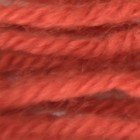 | 4 |
| 2 | Field horsetail | b | 34 | 30 | 20,75 |  | 3 |
| 3 | Alum | b | 30 | 34,50 | 18,75 | 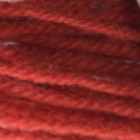 | 5 |
| 4 | Iron (Iron sulphate) | b | 21,60 | 1,10 | 2,50 | 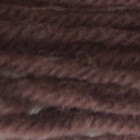 | 5 |
| 5 | Quenching water | b | 31,33 | 28 | 17,40 | 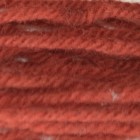 | 4 |
| 6 | Quenching water | a | 33,50 | 31 | 19,30 | 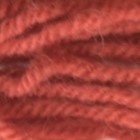 | 4 |
| 7 | Iron water (vinegar-based) | b | 19,80 | -0,80 | 0,79 | 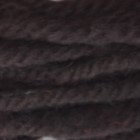 | 5 |
| 8 | Iron water (vinegar-based) | a | 27 | 10 | 9,50 | 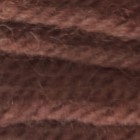 | 4 |
| 9 | Wood ash lye | d | 25,00 | 25,00 | 4,80 | 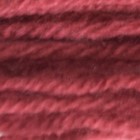 | 4 |
| 10 | Wood ash lye | a | 27 | 26,50 | 8,20 | 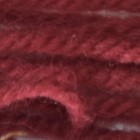 | 4 |
| 11 | Oak galls | b | 32,20 | 25,00 | 19,50 | 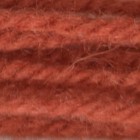 | 3 |
| 12 | Ammonia | a | 28,60 | 25,40 | 12,80 | 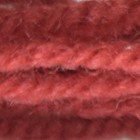 | 4 |
| 13 | Bran water (fresh) | d | 35,90 | 28,50 | 22,00 | 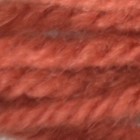 | 3 |
| 14 | Bran water (7 days old) | b | 29,50 | 25,50 | 17,30 | 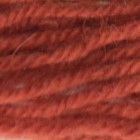 | 3 |
| 15 | Bran water (21 days old) | b | 35,00 | 31,30 | 21,50 | 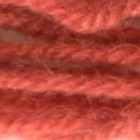 | 4 |
| 16 | Apple vinegar | a | 32,50 | 30,45 | 22,49 | 4 | |
| 17 | No extra substances | n/a | 32,50 | 25,50 | 20,75 | 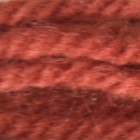 | 3 |
Table 2. CIELAB values and lightfastness of dyed yarns.
| Sample no | Mordant/assist used | Applied: (b)efore/ (d)uring/ (a)fter dyeing | Colour: subjective comparison | Colour: difference in CIELAB standard | Photos: unmordanted/ mordanted | Blue Scale fading (comparing to unmordanted sample) | ||
| L* | a* | b* | ||||||
| 1 | Clubmoss | b | Brighter, different shade (pinkeish red) | -3,01 | -11,10 | -2,00 | 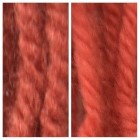 | +1 |
| 2 | Field horsetail | b | Slightly different shade | -1,50 | -4,50 | 0,00 | 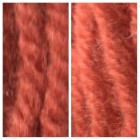 | 0 |
| 3 | Alum | b | Visibly brighter, different shade (pinkeish red) | 2,50 | -9,00 | 2,00 | 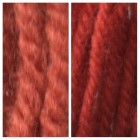 | +2 |
| 4 | Iron (Iron sulphate) | b | Visibly darker, different shade (dark brownish violet) | 10,90 | 24,40 | 18,25 |  | +2 |
| 5 | Quenching water | b | More pinky | 1,17 | -2,50 | 3,35 | 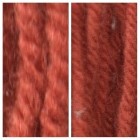 | +1 |
| 6 | Quenching water | a | Slightly different shade (more pinky) | -1,00 | -5,50 | 1,45 | 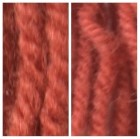 | +1 |
| 7 | Iron water (vinegar-based) | b | Visibly darker, different shade (violetish black) | 12,70 | 26,30 | 19,96 | 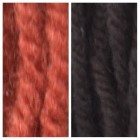 | +2 |
| 8 | Iron water (vinegar-based) | a | Visibly different shade (brown) | 5,50 | 15,50 | 11,25 | 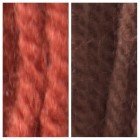 | +2 |
| 9 | Wood ash lye | d | Visibly different shade (purple) | 7,50 | 0,50 | 15,95 | 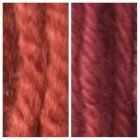 | +1 |
| 10 | Wood ash lye | a | Visibly different shade (purple) | 5,50 | -1,00 | 12,55 | 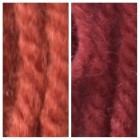 | +1 |
| 11 | Oak galls | b | Different shade (orange) | 0,30 | 0,50 | 1,25 |  | 0 |
| 12 | Ammonia | a | Visibly different shade (purple) | 3,90 | 0,10 | 7,95 | 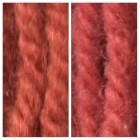 | +1 |
| 13 | Bran water (fresh) | d | Different shade (lighter, more orange) | -3,40 | -3,00 | -1,25 | 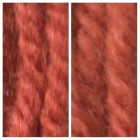 | 0 |
| 14 | Bran water (7 days old) | b | Slightly darker | 3,00 | 0,00 | 3,45 | 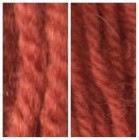 | 0 |
| 15 | Bran water (21 days old) | b | Darker | -2,50 | -5,80 | -0,75 | 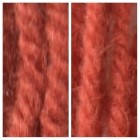 | +1 |
| 16 | Apple vinegar | a | Different shade (brighter) | 0,00 | -4,95 | -1,74 | 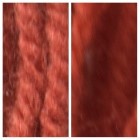 | +1 |
Table 3. The difference in colour and lightfastness between yarns dyed with mordants/assist and plain madder (Rubia tinctoria) dyed yarn.
Conclusions
Mordants and assists available to use for Anglo-Saxon and Anglo-Scandinavian inhabitants can provide a great variety of shades. In the case of madder, the basic brick-red shade could be influenced to such extent that colours such as purple, brown, crimson, and black appeared. Mordants and assists also influenced lightfastness, improving it meaningfully.
From the Coppergate (York) excavations, we can surmise that some mordants were valued equally as dyestuffs as they were shown to be imported from abroad even when dyeing was practised on a small domestic scale. Apart from imported clubmoss, the average Anglo-Saxon or Anglo-Scandinavian dyer had dozens of substances to choose from. Both literary and folk sources provide many possible examples. In most cases, we do not have definite proof of usage of a certain substance, but there are strong arguments for the fact that some mordants and assists were used.
Further research is needed on the subject, and it is recommended that described experiments should be repeated. The purpose of this research, however, was not to provide a complete investigation of the subject but to promote discussion on mordants and assists of the past and to inspire similar experimentation.
Country
- United Kingdom
Bibliography
Balfour, J. B. 1998. Indigo. London: British Museum Press.
Berghe, I. V., Gleba, M., Mannering, U., 2009. Towards the identification of dyestuffs in Early Iron Age Scandinavian peat bog textiles. Journal of Archaeological Science, Vol. 36, 2009, p. 1910-1921
Boutrup, J. and Ellis, C., 2018. The Art and Science of Natural Dyes. Atglen: Schiffer Publishing Ltd.
Bruce-Mitford, R., 1975. The Sutton Hoo Ship Burial: v. 3. 3rd ed. London: British Museum Publication.
Cardon, D. 2007. Natural Dyes. Sources, Tradition, Technology and Science. London: Archetype.
Crowfoot, E., 1990. Textile fragments from 'relic-boxes' in Anglo-Saxon graves. In: P. Walton and J-P. Wild, eds. Textiles in Northern Archaeology, NESAT III: Textile Symposium in York, 6 - 9 May 1987. London: Archetype.
Dean, J., 2010. Wild Colour. London: Octopus Publishing Group.
Dean, J. 2014., A Heritage of Colour. Natural Dyes Past and Present. Tunbridge Wells: Search Press.
Drozdowski, H., 1911. Rośliny użyteczne dla farbiarstwa. Chemik Polski,1911, Vol. 22, pp. 505–509.
Edmonds, J. 2003. The history of woad and the medieval woad vat. 2nd ed. Little Chalfont: John Edmonds.
Fraser, J., 1988. Traditional Scottish dyes and how to make them. Edinburgh: Cannongate Publishing.
Geršak, J., 2013. Design of Clothing Manufacturing Processes. A Systematic Approach to Planning, Scheduling and Control. Amsterdam: Elsevier Science.
Grierson, S. 1992. Dyeing and Dyestuff. London: Bloomsbury Publishing TLC.
Grömer, K., 2016. The Art of Prehistoric Textile Making. 1st ed. Vienna: Natural History Museum Vienna.
Hartl, A, Bommel, M. R., Joosten, I., Keijzer, R., Grömer, K., Rösel-Mautendorfer, H., and Reschreiter, H., 2015. Reproducing colourful woven bands from the Iron Age salt mine of Hallstatt in Austria: An interdisciplinary approach to acquire knowledge of prehistoric dyeing technology. Journal of Archaeological Science: Reports, Vol. 2, pp. 569-595.
Hunt, T., 1995. Early Anglo-Norman Receipts for Colours. Journal of the Warburg and Courtald Insitutes, Vol. 58 (1995), pp. 203 – 209.
Kelso, F., 2011. Plant Lore of an Alaskan Island: Foraging in the Kodiak Archepelago. Bllomington: AuthorHouse. Kenward, H. K. and Hall, A. R., 1995. Biological Evidence from Anglo-Scandinavian Deposits at 16-22 Coppergate (The Archaeology of York 14/7). York: York Archaeological Trust.
Kenward, H. K. and Hall, A. R., 2004. Setting people in their environment: plant and animal remains from Anglo-Scandinavian York. York: York Archaeological Trust.
Kirby, J., van Bommel, R., Verhecken, A., 2014. Natural Colourants for Dyeing and Lake Pigments: Practical Recipes and their Historical Sources. London: Archetype Publications.
Koestler, R. J., Sherryl, R. and Indictor, N., 1985. Identification of Dyeing Mordants and Related Substances on Textile Fibers: A Preliminary Study Using Energy Dispersive X-Ray Spectrometry. Studies in Conservation, Vol. 30, No. 2 (May, 1985), pp. 58-62.
Mahon, B., 1982. Traditional dyestuffs in Ireland. In: Danaher, K. (ed.), Gold Under The Furze: Essays In Folk Tradition. Dublin: Glendale Press, pp. 115 – 128.
Moszyński K., 1929. Kultura ludowa Słowian 1: Kultura materjalna, Kraków.
Owen-Crocker, O., Coatswort, M., Hayward, M., 2012. Encyclopedia Of Medieval Dress And Textiles Of The British Isles, C. 450-1450. Leiden: Brill.
Peachey, S. ed., 2013. Clothes of the Common People in Elizabethean and Early Stuart England. Vol 6: Dyeing. Bristol: Stuart Press.
Pritchard, F. A., 1984. Late Saxon Textiles from the City of London. Medieval Archaeology, 28 (1), pp 46-76.
Sherwood, A.N., Milorad N., Humphrey, J.W. and Oleson, J.P., 1997. Greek and Roman technology : a sourcebook of translated Greek and Roman texts. London ; New York: Routledge, Taylor Et Francis Group.
Vajanto, K., 2015. Dyes and Dyeing Methods in Late Iron Age Finland. Helsinki: University of Helsinki.
Walton, P., 1989a. Dyes of the Viking Age: a summary of recent work. In: P. Walton, ed. Dyes in History and Archaeology 7, (published in 1989 for 1988). London: Archetype, pp. 14-20.
Walton, P., 1989b. Textiles, Cordage and Raw Fibre from 16-22 Coppergate (The Archaeology of York 17/5), London: CBA for York Archaeological Trust
Walton Rogers, P., 1997. Textile production at 16 – 22 Coppergate (The Archaeology of York 17/11). York: York Archaeological Trust.
Walton Rogers, P., 2001. Tests for dye in textile samples. In: Filmer-Sankey, W. and Pestell, T. (eds.) Snape Anglo-Saxon Cemetery: Excavations and Surveys 1824–1992, East Anglian Archaeology 95. Ipswich: Suffolk County Council.

